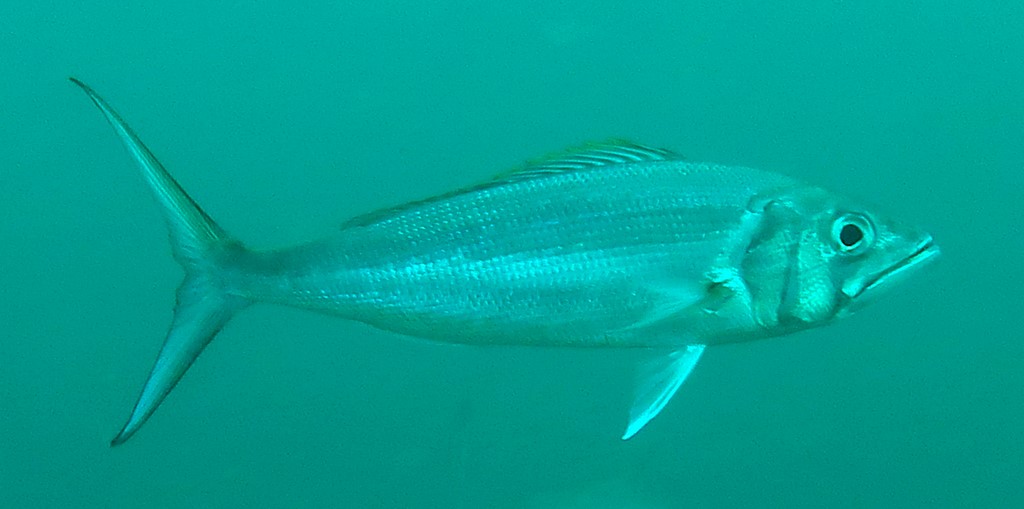APHAREUS RUTILANS - (CUVIER, 1830)
Picture courtesy of: Alain Daoulas
Actinopterygii (Gigaclass) > Actinopteri (Class) > Teleostei (Subclass) > Acanthuriformes (Order) > Lutjanidae (Family) > Etelinae (Subfamily) > Aphareus (Genus)
Lantanier rouge, Vivaneau rouillé, Vivaneau lantanier, Redfin jobfish, Rusty jobfish, Ironjaw snapper, Ironjaw snapper, Ironjaw, Red smalltooth Job, Silvermouth, Small Tooth Jobfish, Smalltooth Jobfish, Small-toothed Jobfish, Small-toothed Job-fish, Pargo de boca vermelha, Pargo bermellón, Ôguchi-ishichibiki, オオグチイシチビキ, 小齿红鲷, 銹色細齒笛鯛, سمك عامل أصدَأ,
Synonymes
Aphareus rutlans (Cuvier, 1830)
Aphareus thompsoni (Fowler, 1923)
-------------------------
Description
Dorsal spines (total): 10; Dorsal soft rays (total): 10-11; Anal spines: 3; Anal soft rays: 8; Pectoral fin rays: 15-16; Gill rakers: 16-19 + 32-35 = 49-52; Lateral-line scales: 69-75. Body elongate, laterally compressed. Roof of mouth toothless; teeth in jaws extremely small, minute in adults. Nostrils on each side of snout close together. Lower jaw protruding. Premaxillae not protrusible. Scale rows on back parallel with lateral line. Max. length: 110 cm TL, common length: 79.0 cm SL. Max. published weight: 11.3 kg. Depth range: 5 - 350 m.
Color
A bluish-grey to mauve or reddish jobfish with yellowish to reddish dorsal, pectoral and caudal fins, and a dark margin on the upper jaw.
Etymology
Aphareus: from Greek, aphareys, -eos = water wings under the belly of female tunna. A name from an “unintelligible and probably corrupt passage from Aristotle, where it seems to designate a fin specific to the female of the tuna” (translation), which Cuvier applied this genus (also similar to its Arabic name farès, but this may be a coincidence).
rutilans: from Latin, rutilus = of a warm or yellowish red colour, ruddy. Referring to rusty or reddish color of head and back and pink fins.
Original description: Aphareus rutilans Cuvier, 1830 - Type localities: Red Sea; Possibly also Mauritius, Mascarenes, southwestern Indian Ocean; Indonesia.
Description
Red Sea; Indo-West Pacific: East Africa, South Africa, Socotra, Comoros, Madagascar and Mascarenes east to Hawaiian Islands, north to southern Japan and Ogasawara Islands, south to northern Western Australia, Queensland (Australia), New Caledonia and Tonga.
Biology
Adults inhabit reefs and rocky bottom areas. Found in pelagic and benthopelagic waters. Occurs solitarily or small groups. They feed on fishes, squids and crustaceans. Spawning occurs during spring and summer. Taken on handlines and longlines in deep-water fisheries throughout its range. Marketed fresh.
Similar species
Aprion virescens (Valenciennes, 1830) - Reported from New Caledonia - Link to the species (here).
Last update: 29, March 2022
Actinopterygii (Gigaclass) > Actinopteri (Class) > Teleostei (Subclass) > Acanthuriformes (Order) > Lutjanidae (Family) > Etelinae (Subfamily) > Aphareus (Genus)
Lantanier rouge, Vivaneau rouillé, Vivaneau lantanier, Redfin jobfish, Rusty jobfish, Ironjaw snapper, Ironjaw snapper, Ironjaw, Red smalltooth Job, Silvermouth, Small Tooth Jobfish, Smalltooth Jobfish, Small-toothed Jobfish, Small-toothed Job-fish, Pargo de boca vermelha, Pargo bermellón, Ôguchi-ishichibiki, オオグチイシチビキ, 小齿红鲷, 銹色細齒笛鯛, سمك عامل أصدَأ,
Synonymes
Aphareus rutlans (Cuvier, 1830)
Aphareus thompsoni (Fowler, 1923)
-------------------------
Description
Dorsal spines (total): 10; Dorsal soft rays (total): 10-11; Anal spines: 3; Anal soft rays: 8; Pectoral fin rays: 15-16; Gill rakers: 16-19 + 32-35 = 49-52; Lateral-line scales: 69-75. Body elongate, laterally compressed. Roof of mouth toothless; teeth in jaws extremely small, minute in adults. Nostrils on each side of snout close together. Lower jaw protruding. Premaxillae not protrusible. Scale rows on back parallel with lateral line. Max. length: 110 cm TL, common length: 79.0 cm SL. Max. published weight: 11.3 kg. Depth range: 5 - 350 m.
Color
A bluish-grey to mauve or reddish jobfish with yellowish to reddish dorsal, pectoral and caudal fins, and a dark margin on the upper jaw.
Etymology
Aphareus: from Greek, aphareys, -eos = water wings under the belly of female tunna. A name from an “unintelligible and probably corrupt passage from Aristotle, where it seems to designate a fin specific to the female of the tuna” (translation), which Cuvier applied this genus (also similar to its Arabic name farès, but this may be a coincidence).
rutilans: from Latin, rutilus = of a warm or yellowish red colour, ruddy. Referring to rusty or reddish color of head and back and pink fins.
Original description: Aphareus rutilans Cuvier, 1830 - Type localities: Red Sea; Possibly also Mauritius, Mascarenes, southwestern Indian Ocean; Indonesia.
Description
Red Sea; Indo-West Pacific: East Africa, South Africa, Socotra, Comoros, Madagascar and Mascarenes east to Hawaiian Islands, north to southern Japan and Ogasawara Islands, south to northern Western Australia, Queensland (Australia), New Caledonia and Tonga.
Biology
Adults inhabit reefs and rocky bottom areas. Found in pelagic and benthopelagic waters. Occurs solitarily or small groups. They feed on fishes, squids and crustaceans. Spawning occurs during spring and summer. Taken on handlines and longlines in deep-water fisheries throughout its range. Marketed fresh.
Similar species
Aprion virescens (Valenciennes, 1830) - Reported from New Caledonia - Link to the species (here).
Last update: 29, March 2022
